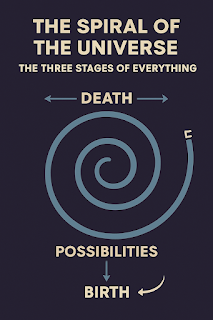The Spiral of the Universe: The Three Stages of Everything
To me, the universe feels like a spiral. It appears circular, yet it's not a closed loop. Every time it turns, something changes, new possibilities arise, and nothing ever repeats exactly the same. Everything, from the tiniest atom to the vastest galaxy, seems to follow a recurring pattern of three essential stages:
- Death
- Possibilities
- Birth
Even within these stages, the same cycle exists. Death consists of: the birth of death, its possibilities, and the death of death. Possibilities carry their own birth, transformation, and end. And birth too is incomplete without its death and the possibilities it creates.
In essence, the flow of the universe might be visualized like this:
...>Death<>Possibility<>Birth<>Possibility<>Death<...
When the universe dies, new possibilities emerge. If the Big Bang truly happened, then it could be the death of a former universe. The explosion created galaxies, stars, planets, moons, meteors, black holes — everything that exists today. And one of those infinite possibilities led to Earth — a planet where life emerged that could think, and it's because of this thinking that I am even writing this.
If we consider Earth alone, there is only one creature trying persistently to defy natural extinction: the human being. In doing so, humans are breaking the fundamental rule of nature. Everything would’ve been easier without consciousness. Earth would’ve become overly fertile, nature would’ve flourished, and eventually, everything would’ve ended naturally. But human intervention has disrupted this process — exploited Earth’s resources, damaged ecosystems — and though Earth may perish, it's uncertain whether humans will. Because we are already looking at Mars — trying to break the natural rule there too.
Still, as a human, I admit: I want to survive. I like living. And so, I stand in favor of this violation of nature’s law.
Another question arises: What is at the edge of the universe? This, I believe, is a deeply psychological question — only a conscious mind would ask this. My answer is simple: there is no end. We want there to be one. We imagine walls, and behind every wall, another room, and another. But we never see an end. The truth might be that our brain is not yet developed enough to comprehend the concept of infinity. Or perhaps we’ve convinced ourselves that everything must have an end — including the universe. And in doing so, many created a theory or belief just to fill this gap — and we called it God.
From atoms to the cosmos, everything that exists occupies space. Existence requires space. Space, or place, is the one thing that has always existed — and always will. It’s where the entire process of the universe unfolds. It’s where death, birth, and possibilities occur in a continuous spiral. A time will come when everything returns to nothing. But that too, is a beginning — a rebirth of the universe in the form of space. Maybe another explosion will occur, and maybe this time Earth-like life won’t emerge. Or maybe it will, but without minds like ours. Perhaps some other entity will rule.
So, in summary, everything in the universe — living, non-living, natural, man-made, or even abstract like thoughts — follows the three stages of everything. And you can’t escape it.
This was the first question and the first answer of the universe. In the next blog, I’ll talk about Earth and its people.
Why Does Change Happen?
Every beginning points to something new. And so, the beginning of the universe was also the result of something new. But why does newness exist at all? Why do things change? And how does this change happen?
After a lot of thought, I’ve come to believe that everything in existence — every event, every process — follows a fixed yet complex pattern. If you do X, Y will happen. If you do A, B will follow. It seems simple, but it’s not. There are multiple factors that work in a complex order.
Let’s understand these in five core ideas:
-
Cause and Effect
A cause is what triggers something; the effect is the result. But for this to happen, change must occur. And that change must involve some form of energy, matter — something to act upon. At the atomic or subatomic level, there are countless such events occurring. -
Domination
Domination is when one thing overpowers another. Much like cause and effect, but more directional. The stronger side affects the outcome, but the weaker is still part of the process. Both contribute — just in different capacities. -
Birth
Birth is nothing but a change — a beginning of something new. It could be a particle, a molecule, an idea, a philosophy, a theory — anything. -
Possibilities
Every birth gives rise to infinite possibilities. These possibilities then go through their own cycle of birth, transformation, and end. This cycle is spiral — not circular — constantly evolving. -
Death
Everything that exists must end. Be it physical or abstract, it will die. But even death is filled with possibilities. Life and death are momentary, but possibilities are eternal.
If we break down the universe:
- Matter, atoms, and elements are the components.
- Cause and effect are the functions.
- Domination is the force behind how those functions happen.
- Birth, Possibilities, and Death are the process — the spiral.
And so, the spiral goes on...
The Gap in India's Modernization

Comments
Post a Comment